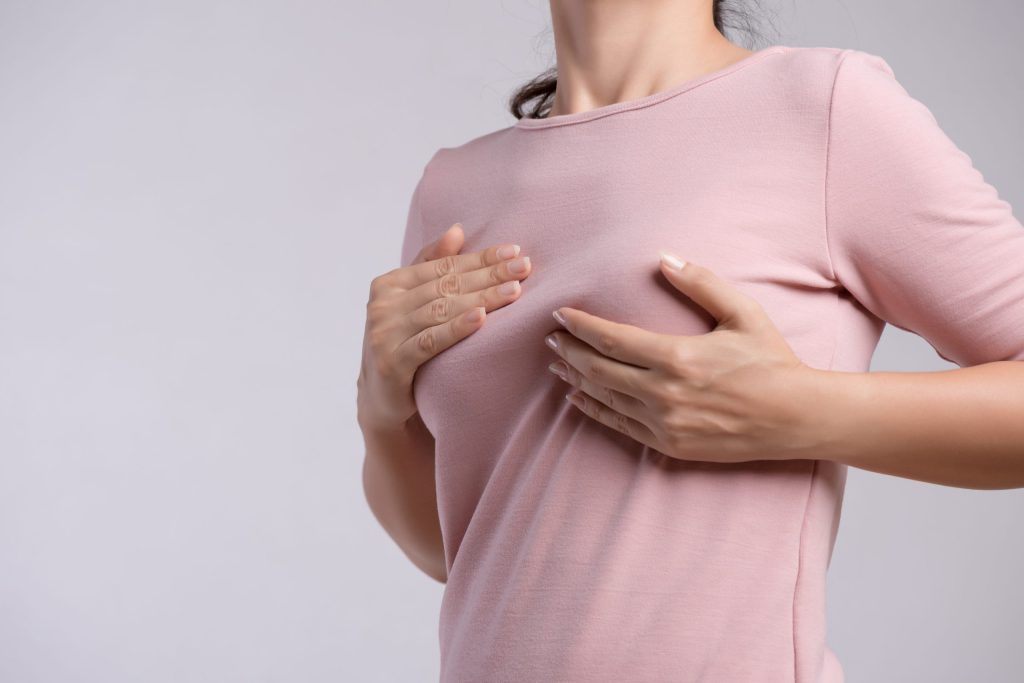Fat necrosis—the lumps that sometimes appear after fat grafting breast augmentation—is a troubling occurrence for patients after the procedure. However, having a hard lump after natural breast augmentation or reconstruction is a benign event that is more of a cosmetic issue and a matter of physical comfort than a serious or life-threatening health concern. Here, we provide answers to some of your questions about lumps after fat transfer to the breast.
Can Fat Transfer to the Breast Cause Lumps?
Fat transfer, also known as fat grafting, is a popular technique for breast augmentation and breast cancer reconstruction, as it utilizes the patient’s own tissues to sculpt and refine the breasts without installing a synthetic device. Multiple fat grafting sessions can be necessary to generate the patient’s desired results.
While the procedure is generally safe when performed by qualified plastic surgeons, it may lead to complications if performed too frequently or by a less-than-stellar practitioner. These complications often include the appearance of hardened and sometimes painful lumps in the breast, which can be highly distressing for patients.
What Are lumps After Fat Transfer to the Breast?
Hardened masses that appear post-fat grafting breast augmentation are typically caused by fat necrosis. Fat necrosis is a common complication that may result in either hardened lumps or oil cysts. Oil cysts occur when fat necrosis dissolves and forms a calcified cyst over liquid fat, which feels smooth and pliable.
Hardened lumps, on the other hand, may cause physical discomfort and cause the skin to bruise. When fat necrosis solidifies into scar tissue, it creates a solid inflexible mass that may be painful.
Patients who experience fat necrosis after fat grafting breast augmentation may experience a combination of oil cysts and hardened lumps, both caused by fat necrosis.
Common Fat Necrosis Symptoms Are:
- A firm or pliable lump in the breast after fat transfer
- Redness surrounding the lump
- Slight bruising surrounding the lump
What Causes Hard Knots After Natural Breast Augmentation?
Poor technique during fat transfer to the breasts can sometimes cause fat cells to die due to a lack of oxygen and blood supply. Breast augmentation with fat transfer is a common trigger for fat necrosis because the grafted fat cells may not survive and ultimately form scar tissue.
A 2018 study published in the Annals of Surgical Oncology reviewed the records of 171 patients who had fat transfer breast reconstruction surgery. They found that a little over 10% of patients experienced fat necrosis an average of 3.4 months after fat transfer. None of the patients experienced a recurrence of breast cancer.
The Los Angeles breast specialists at Bedford Breast Center can recommend a team of highly skilled plastic surgeons at Cassileth Plastic Surgery who specialize in breast reconstruction through fat transfer. By using some of the latest innovations in fat transfer technology and techniques, our breast surgeons are able to increase the likelihood that the fat will survive in its new location. Patients served by our team experience significantly lower incidences of fat necrosis than the national average.
How Do You Treat Hard Lumps After Fat Grafting Breast Reconstruction?
After your physician determines that the masses in the breast are due to fat necrosis and are not cancerous cells, you may elect to treat it or monitor it to see if it dissipates on its own. However, if the lump is causing significant discomfort or aesthetic problems, it may be advisable to address it surgically.
Surgical intervention for fat necrosis generally involves ultrasound guidance to effectively locate all hardened lumps. Needle aspiration then causes an oil cyst to dissolve quickly. (We explain the needle aspiration biopsy process in a related blog post.)
The procedure only requires a local anesthetic, and recovery from the procedure is typically short. Most people need only approximately 2 to 4 weeks of recovery time, depending upon the size and number of the lumps. Multiple lumps may require multiple treatment sessions.
Can Fat Transfer to the Breast Cause Breast Cancer?
No. There is no increased risk of breast cancer after natural breast augmentation or breast reconstruction. While lumps after fat grafting can be concerning, they aren’t cancerous, nor do they increase breast cancer probability. Nevertheless, they should be checked and removed, as they can be painful and cause the breasts to appear misshapen.
Bedford Breast Center: The Leading Breast Cancer Treatment Center in Beverly Hills
If you have issues with hard lumps after fat grafting breast augmentation, don’t hesitate to contact the breast specialists at Bedford Breast Center for an immediate consultation. You can contact us online or call us at (310) 278-8590. We offer compassionate, comprehensive breast health services to women with all types of breast issues in the Beverly Hills, Santa Monica, and greater Los Angeles area.

